The 12-string kantele SM579 in the Sibelius Museum, built by Teppo Repo
Blog
March 03, 2024

Teppo Repo, Helsinki 1958. Photo: István Rácz. The Finnish Heritage Agency. CC BY 4.0.
The 12-string kantele SM579 in the Sibelius Museum was built by Teppo Repo (1886-1962). He was born in Ingria and became famous in Finland as a shepherd’s musician.
Tellervo Hämäläinen, the widow of Antti Hämäläinen (1897–1976), who was also born in Ingria and later became a Finn, donated the kantele to the Museum in 1980. In addition to the kantele, the donation included an interview with Teppo Repo conducted by Antti Hämäläinen in 1955 (SmL3347).
Hannu Saha has written about Teppo Repo in the National Biography of Finland and in the CD booklet Paimensoittaja Teppo Repo (KICD 7). He also wrote his master’s thesis on Teppo Repo for the University of Tampere in 1982. Saha has also written about Teppo Repo’s kantele playing style in A Guide to the 10-string Kantele (Folk Music Institute publications 21, 1986).
Teppo (Teodor) Repo, originally named Feodor Nikitin Sofronoff (Safronoff from 1919), was born on 7 November 1886 in Soikkola, Viistinä village, western Ingria, and died on 6 January 1962 in Helsinki, Finland. He was the second eldest child in an Izhorian family of four children in a small country house. His father died when he was three years old. According to him, he started working as a shepherd’s helper at the age of 5. He became a shepherd’s assistant at the age of 8 and an independent shepherd at the age of 13. In accordance with local custom, additional income was earned from fishing during the winter season, so Teppo Repo’s education was limited to two years at public school.
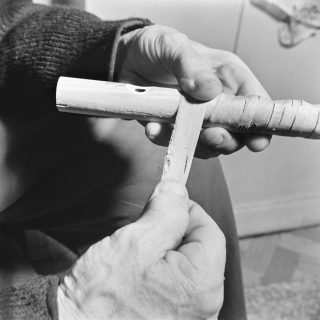
Teppo Repo makes a shephard’s flute. Photo: István Rácz, 1958. The Finnish Heritage Agency. CC BY 4.0.
Repo learned the art of making and playing various flute, horn and clarinet instruments from the older representatives of the shepherd tradition in his family. He learned to play the kantele from his mother, Aleksandra Sofronoff. The kantele had 11 strings and, according to Repo, his mother took him to play it at women’s parties when he was 5 years old.
During his three-year military service in the Russian Imperial Army from 1908, Repo worked for two years as a horn player in a military band near the Austro-Hungarian border. It was during this time that he learnt to read and write music, and his own music was influenced by military music. According to A. O. Väisänen, the birchbark horn may have saved Repo’s life, because Repo was transferred to the military band after a high-ranking officer heard him play the shepherd’s horn, and thus Repo avoided the worst of the coming world war.
Repo first came to Finland in 1911 and worked as a passport policeman in Helsinki until 1916. He then returned to the military band until he finally moved to Finland at the end of the First World War. At first he worked as a furniture packer and shoemaker, but from 1921 he worked as a Singer sewing machine mechanic for more than 30 years. In Finland he changed his name from Safronoff to Repo, his religion from Orthodox to Lutheran and married a Finnish woman, Hilja Sjöblom from Yläne.
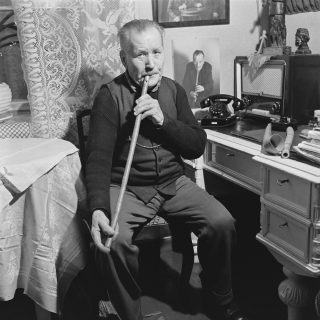
Teppo Repo, 1958. Photo: István Rácz. The Finnish Heritage Agency. CC BY 4.0.
Teppo Repo played several instruments (various wind instruments, taljanka, mandolin, kantele, balalaika, violin), but in Finland he became especially known as a creative master of shepherd’s instruments. In addition to the traditional tunes he played, he also composed a lot of his own music and often improvised “from his own head”. In Finland, he started making shepherd’s instruments in the 1920s and sold several hundred of them – such instruments can still be found in both private and museum collections.
Armas Otto Väisänen met Teppo Repo in 1935 and invited him to perform frequently on the radio and at various events in Finland and abroad. At Väisänen’s suggestion, Repo changed his first name from Teodor to Teppo and also learned to play two flutes at the same time.
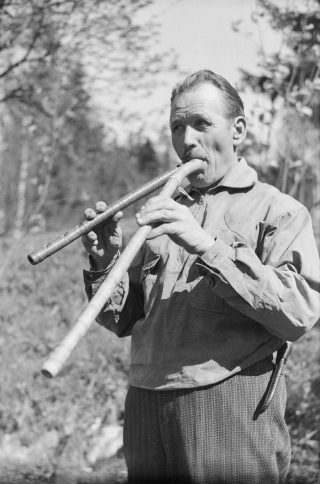
Teppo Repo. The Finnish Heritage Agency. CC BY 4.0.
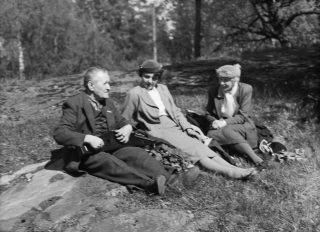
Teppo Repo, Kirsti Gallen-Kallela and Anna Slöör on the rock of Meilahti in Helsinki. The Finnish Heritage Agency. CC BY 4.0.
In addition to radio, Repo became known to a wider audience through television, films, the press and recordings. Repo’s music and interviews have also been deposited in archives (e.g. Finnish Literature Society, University of Tampere Folklore Archive, Folk Music Institute, Yleisradio, Sibelius Museum). The album Paimensoittaja Teppo Repo (KICD 7) contains music played with both shepherd’s wind instruments and the kantele. In addition to Väisänen, Repo’s supporters included Marjatta and Martti Pokela, Erkki Ala-Könni and Ahti Sonninen.
According to Hannu Saha, Repo became an honorary member of the Metropolitan Museum of Art (New York, USA) in 1948. One of his instruments should also be there.
Repo played the kantele with the strumming technique, where the left hand mutes the strings and the right hand hits or pulls the open strings to play. Repo used only one finger position, muting every other string with four fingers of his left hand, from thumb to ring finger. He would change the position of his left hand up and down the strings at a fast tempo to match the music.
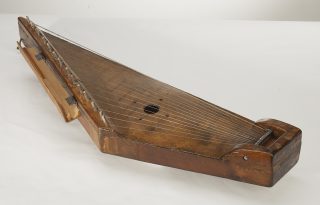
A 14-string kannel made by Teppo Repo in 1958 (SU5572:1). The National Museum of Finland. CC BY 4.0.
The National Museum of Finland owns a 14-string kantele (SU5572:1) made by Teppo Repo, which is similar in construction to the one in the Sibelius Museum. The kantele was made three years after the 12-string kantele in the Sibelius Museum.
Antti Hämäläinen (1897–1976), the author of the interview with Teppo Repo in the archives of the Sibelius Museum, was also born in Ingria. In the village of Malkkila in Skuoritsa he was called Andrus Andreaksenpoika Hämäläinen.
Hämäläinen began his studies at the Teachers’ and Apprentices’ Seminary in Kolppana, Ingria, but his studies were interrupted by the turmoil of the First World War and the Russian Revolution. (The population of Kolppana was mainly Äyrämöiset, i.e. Lutheran Karelians who had immigrated to Ingria from the western part of Karelia, mainly from the Äyräpää district, in the 17th century).
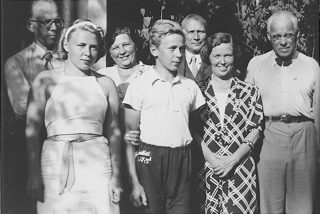
Ingrian Finns. Antti Hämäläinen behind on the left. In the front row from the left: Anja Savolainan (Samooja), Martti ja Taimi Savolainen, Konstantin (Kosti) Kupiainen. The Finnish Heritage Agency. CC BY 4.0.
Hämäläinen went to the noncommissioned officers’ school, ended up in a penal colony in Siberia (and, according to Toivo Flink, once in the Špalernaja remand prison) and then at the front. He eventually returned to the seminary in Kolppana, but when it was closed in 1919, he moved to Finland via Estonia with the last class of students. Kaapre Tynni, the director of the seminary, who had already moved to Finland, arranged for the students to finish their studies in Helsinki, and so Hämäläinen graduated as a public school teacher in 1920. While working as a teacher, he continued his studies at the Sortavala seminary from 1920 to 1924, and from 1926 to 1934 he also studied ethnology at the University of Helsinki. Hämäläinen developed an early interest in the folklore of Ingria, which continued throughout his life.
In 1920–1928 Hämäläinen worked as a teacher in public schools in Finland (Karinainen Kyrö, Malkkila in Heinävesi, Loue in Tervola and Uusikaupunki). In 1928–1930 he was the headmaster of Itä-Häme folk college and home economics school in Hartola. From 1930 to 1937 he was the inspector of public schools for the Lapland district, and finally from 1937 to 1964 he was the inspector of public schools for the Turku district. He died in 1976 in Lieto, Finland.
During his time in Turku, Hämäläinen published several books, e.g. about Lapland and Ingria. During the Second World War (the Continuation War in Finland), he worked in his home region of Ingria in the fields of education and culture, and helped to relocate the Ingrians from German-occupied areas to Finland. When he returned to Finland, he deposited the 2,500 photographs he had taken in the National Museum.
Together with his wife Tellervo Hämäläinen, Antti Hämäläinen interviewed the Ingrians in Finland and Sweden for several years after the Continuation War. These 200 interviews were donated by Tellervo Hämäläinen to the archives of the Finnish Literature Society and the Finnish Heritage Agency in 1976. In addition to Ingria, Antti Hämäläinen recorded the lives of people in Lapland and Setomaa, and in 1971 he donated a collection of some 9,000 photographs to the Finnish Literature Society. Tellervo Hämäläinen donated Teppo Repo’s kantele and an interview conducted by Antti Hämäläinen to the Sibelius Museum in 1980 [SmL3347_Kopia av en interview med Teppo Repo (1955)]. According to the marking on the inside of the kantele, the kantele was completed on 5 May 1955, the same year as the interview in question. The recording contains samples of Repo playing the shepherd’s wind instruments and the kantele.
In an interview with Antti Hämäläinen, Teppo Repo says that he originally made the kantele he plays with 11 strings, but later added a 12th string because he needed it in his music. The 12th string on the Sibelius Museum kantele has clearly been added later: its tuning peg is not in line with the other pegs, and its distance from the previous peg is significantly shorter than the distance between the other tuning pegs.




The kantele SM579 has 12 strings and is hollowed out from the top. It has a separate top plate, a separate wooden bar under the tuning pegs, and a two-piece armrest that is hinged to the side of the tuning pegs.
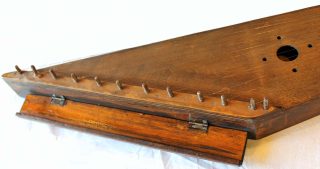
The end side is straight, without the downward ponsi element typical of Finnish-Karelian kanteles.
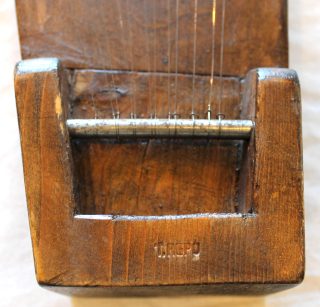
The end is made of solid wood. It extends slightly beyond the edge of the top plate.
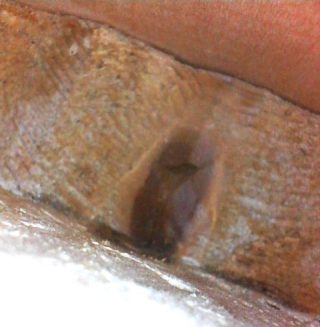
The end side inside.
The strings on the iron bar are quite close together and partially grouped in pairs – intentionally or not, I can’t say. In small kanteles intended for strumming, it is not at all unusual for the strings to be close together at the end side.
